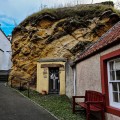People have lived in Fife for thousands of years and nowhere is that more obvious than at East Wemyss. Naturally formed by the sea, the Wemyss Caves were ready made shelters for early Fifers with a seafood bounty on their doorstep.
Only six caves remain, but each has its own unique story to tell.
Some of the cave activity is associated with MacDuff Castle, sitting on the cliff directly above. Legend says that Court Cave was used by the Thane of Fife as an area large enough to gather his followers. Whether he delivered any judgements here is up for debate, but the name has stuck along with rumours of secret tunnels between several of the Wemyss Caves and the castle.
Many noble families built a dovecot or doocot near their fortress to provide safe nesting for birds used as a source of meat. At Wemyss they used Doo Cave instead. Rows of boxes have been cut into the stone as welcoming homes for pigeons, creating the most unique doocot in Scotland.
Directly below the castle, Well Cave was once the location of a holy spring. For centuries, youths from around East Wemyss would enter the cave to drink from St Margaret’s Well every Handsel Monday. The water source has now sadly been diverted and the tradition long since died out.
The most intriguing story from the Wemyss Caves, surrounds even earlier inhabitants. These caves hold the highest concentration of Pictish symbols found anywhere in Scotland. Not only are the carvings inside beautiful, but they’re also a fascinating glimpse into some of the most mysterious people to walk these shores.
We have no written accounts from the Picts themselves, so their language and culture has been lost to the mists of time. What we do have are hundreds of carved symbol stones scattered across Scotland, with no idea of their meaning.
The Wemyss Caves contain dozens of these images, created even before those elaborate standing stones appeared. There are 60 recognised Pictish symbols featured all over Scotland and these caves once displayed 49 of them.
Clamber into the large Jonathan’s Cave and travel back 1500 years. Discover clearly outlined fish, imagine what animal the strange beast represents and ponder over peculiar carved double discs. Further towards the back of the cave, one of the most interesting depictions is an early representation of a Viking longship. It can take a bit of searching, but the prow and oars are unmistakeable.
Sadly, the powerful sea that created this fascinating collection of caves is now at risk of destroying them. Tidal defences have been installed to hold back the waves, but this amazing historical evidence may eventually be lost forever. Thankfully, the caves have now been successfully laser mapped and each of the Pictish carvings all digitally recorded.
There are few locations in Fife as historically important as the Wemyss Caves, where you can walk through history from some of our earliest ancestors right up to the modern day.
Storytelling by Scotland's Stories




